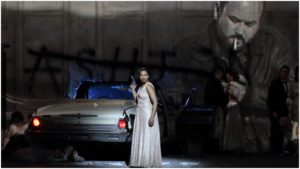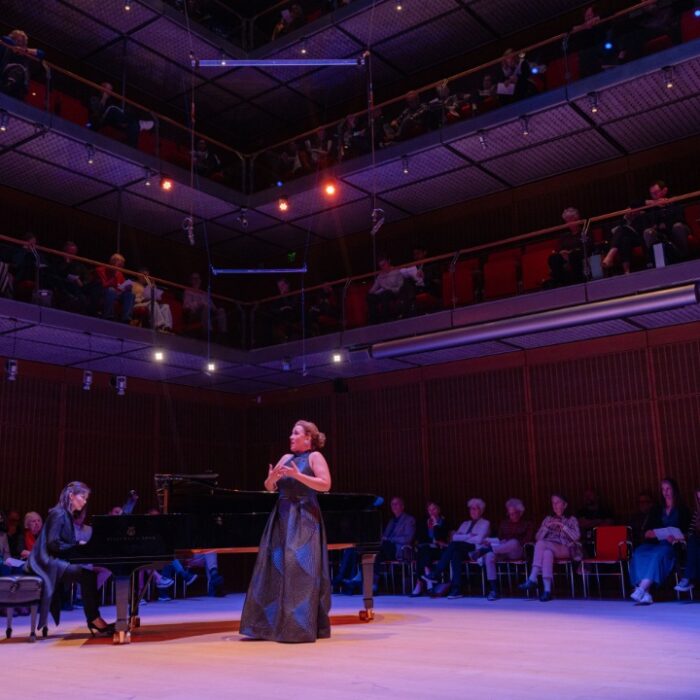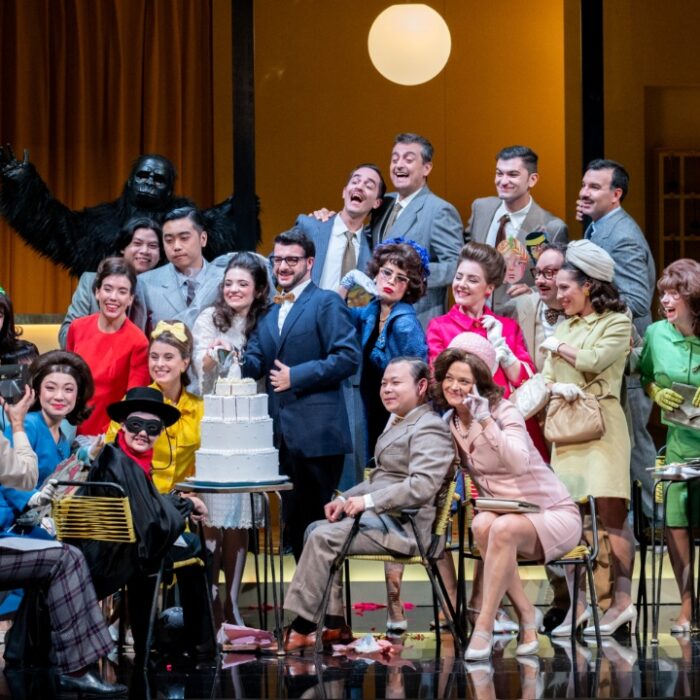
Bayerische Staatsoper Review 2018-19: Lucia di Lammermoor
Pretty Yende & Javier Camarena Lead A Tremendous Cast In a ‘Bel Canto’ Feast
By Mauricio Villa(Credit: Wilfried Hösl)
It is a magical moment when the finest singers in the world, along with strong musical guidance and with a meaningful dramatic production are combined together.
That is exactly what happened on the evening of the June 9, 2019, when the Bayeriche Staatsoper revived Barbara Wysocka’s production of “Lucia di Lammermoor” with the “Bel canto couple” of the moment: Pretty Yende and Javier Camarena. They were joined by George Petean as Enrico, Alexander Vinogradov as Raimondo and Antonino Fogliani at the pit. Every singer gave their best and Fogliani provided the most passionate reading of this Donizetti’s masterpiece that I have ever heard; the audience really appreciated it, being timid and respectful through the performance, but excited and enthusiastic during the curtain call.
We are living in a “Bel Canto” renaissance, not only by restoring forgotten tittles but by casting voices able to fulfill all the demands of the score, opening traditional cuts and therefore performing the complete work in their original key and with all the notes written on the vocal lines. In the case of this performance of “Lucia di Lamermoor,” there was also the use of the Glass Harmonica in the mad scene as Donizetti intended rather than a flute imposed by tradition. Only because “Petean” did not repeat his cabaletta as written, the score was not complete, but every other single bar was performed that night, including the whole coda in “Lucia’s” first cabaletta “Quando rapita in stasi,” which is usually completely cut or sung once.
A Veritable Lucia
Pretty Yende has conquered the stages of the most notable opera houses around the world and as Lucia, she provided the perfect voice for this role. Having a lyrical instrument by nature with a strong centre and dark sound, she had no trouble with a score which is basically written for the middle of the voice. If we take away all the notes and cadenzas added by tradition we will find that the mad scene for example does not go higher than B flat (with a couple of high Cs in “oppure”) as it happens with most of the role. She has a depurated coloratura and stratospheric high notes that you would not believe would come out of this voice. Her interpretation of the cavatina “Regnava nel silenzio” was chilling to the bones; she was so expressive and perfectly on pitch and resonance while descending to the several low Cs, something which troubles lighter voices, but then she went into the cabaletta and began to display fast clean coloratura, imaginative and terribly difficult variations of her creation ascending to a E natural in “staccato” and adding an extra high D on the second repetition of the coda. The duet with Edgardo was pure magic and lyricism.
Her entrance during the second Act duet with Enrico, “Il palor funesto orrendo” was strong, determined and aggressive, while “soffriva nel pianto” featured long legato and sadness, sung with a “fil di voce” portraying a great sense of betrayal, disappointment and abandonment which kept up in the next scene with Raimondo. The moment when Lucia is forced to sign the wedding contract was breathtaking and Fogliani allowed a pause in the music long enough to give her time to sign the paper with resignation before interpreting the line “io gelo ed ardo” with a tremendous pathos followed by a desperate “io manco” with an emphatic A flat which filled the whole house. Her voice was properly present during the famous sextet and the concertante finale”which coronated, alongside Camarena, with a long ringing high D.
And then came Lucia’s famous Mad scene. As I explained before , and many sopranos have expressed the same, the difficulty of this scene is in portraying and carrying the drama; it’s true that there is coloratura in the cabaletta but it is not harder than the vocal challenges you can find in “Anna Bolena” or “Lucrezia Borgia” from the same composer. Yende’s imaginative and dramatic way of portraying a homicidal girl who is delusional and bi-polar with constant change of mood from happiness, to fear, hate and sadness, was astounding. And vocally she just gave everything she had, decorating the score with her own ornamentations, always respecting a dramatic purpose rather than a spectacle of “fioriture” and high notes. She went into a high E natural on the phrase “Oh goia che si sente” rather than staying on the high C as is usually done. Her cadenza has everything you expect to hear: staccato notes, pianissimi, coloratura, high notes, etc. Wisely enough she decided to reprise the motif of “soffriva nel pianto” as a remembrance of when she believed herself abandoned by Edgardo, rather than the motif of the love duet, which better suited the melancholic tone of the glass harmonica. And as if she has not done enough, she went into a high F before resolving the cadenza down in a wonderful diminuendo, again more according to the original intentions of Donizetti who wrote “piano” for the ending. Her voice was fresh enough to perform an immaculate “Spargi d’amaro pianto” full of dramatic coloratura and ending with a sustained E flat before falling down fainted on the floor.
The Bel Canto Tenor of Our Time
The role of Edgardo has probably never been sung the way Javier Camarena sings it, with perfect breath control and legato, a beautiful timbre with unlimited resources to color the phrases, perfect crescendos and diminuendos and top ringing high notes up to high E flat; and above all a perfect sense of drama. He uses his voice and resources to enlighten his character, nothing is coincidental or a demonstration of vocal abilities. Camarena has finally restored all the high notes written in the score, which has always been avoided (and the high E flat of the duet with “Lucia” in Act one is written as the only vocal line of the tenor, not as the C sharp of “Tu che a dio” which is “oppure”) and even added a few high D’s and C’s; there have been some timid attempts in latter years to sing the high E flat in the duet, but they were usually small voices that struggled with the more dramatic parts of the score, or was sung in falsetto. In other instances the results were strained and forced, a far cry from Camarena’s rendition, which sounded like another beautiful note in the duet.
Camarena appears on stage driving a Cadillac wearing a leather jacket and goes into the recitative: “Lucia perdona” with vigor and energy turning into anger and reproach. He colored his voice with darkness and carefully projected the sound before going into phrases like “ma ti vidi, e in cor mi nacque” with delicacy and softness, singing his first high B flat on the word “Sì” as it is written on the score, rather than changing to a more open comfortable vowel like “a,” as the greatest tenors have always done. Listening to Camarena you have the feeling that he can just sing everything. No matter how high, low, loud or soft the notes are, his technique is so secure and the sound so beautiful that you are not conscious of the difficulties of the parts he is singing; you just enjoy his performance. He sang the whole phrase “Verranno a te sull’aure I miei sospiri ardenti” in a single breath (as did Yende), and it is not an easy task to accomplish as is a long phrase and written in the passagio, which is quite uncomfortable to sustain; it’s all the more difficult when you consider that he made a tremendous diminuendo on the high G of this passage. Yende and Camarena voices blended perfectly when singing together and their duet in the first act was one of the highlights of the evening.
Edgardo appears again in Act two in another dramatic entrance when he interrupts the wedding between Lucia and Arturo. After a perfectly sung “Chi mi frena,” where his voice was always present in ensemble, he dispatched all his fury into “Hai tradito il cielo, e amor. Maledetto sia l’istante” without sounding melodramatic or over acting. It is incredible how clever he is and how deep a knowledge he has of his instrument to be able to portray and transmit such strong feelings, making them believable but always respecting the “Bel Canto” style. All of these violent outbursts have always led to miscasting Edgardo with heavy or spinto voices. This usually results in lowering the key of some passages ( like the last scene), with the tenors struggling to sing softly in the passagio and avoiding most of the high notes. Camarena even sings the sentence “Ah! Ma di Dio la mano irata” before attacking the high B flat while most tenors usually just skip the phrase to rest and breathe properly before the high note. The scene with Enrico at the beginning of Act three kept all his standards: good singing, interpolated high notes and strong characterization. It was astonishing how he acted wounded throughout the whole duet as the scene began with Edgardo falling out his car after a car crash.
As for the final scene of the opera, it is essential to note that it is really complicated for the tenor. After the long and glorious mad scene, it can be truly challenging to retain audience interest and attention. And secondly, “Tombe degli avi miei” is very hard to sing as the whole page lies on the middle and lower register of the voice. This is a particularly unique challenge for someone like Camarena whose voice doesn’t vibrate as easily in those lower registers. And yet, he sang this passage beautifully and effortlessly. “Fra poco a me ricovero” is a bit more insistent on the passagio and it is here where Camarena shines, being able to sing every single dynamic marked in the score. His high B natural during the cadenza was ringing and resonant, filling the whole auditorium. It was hair-raising the way he interpreted the phrase: “ Lucia più non è?” I would have never thought that singing this phrase with pianissimi would make such an effect of despair and pity. His interpretation of “Tu che a Dio spiegasti l’ali” has really no competition; the phrase “Teco ascenda il tuo fedel” with the optional high C sharp completely changes the melody, and because Camarena is able to attack the note with a single breath, keeping the legato soft, he reinforces the sadness and desperation of Edgardo in this moment. He gave a lesson of perfect singing in “o bell’alma innamorata,” once again respecting all of the indications in the score in this devilish high passage. Usually the soprano gets the biggest ovation in this opera, but that night, the ovations for Camarena and Yende were even.
Robust Low Voices
The Romanian baritone George Petean played the role of Enrico; he has a strong robust sound, with a rich timbre and perfect vibrato. He is a regular in the Verdi and Verismo repertory, but he can control his heavy voice and assume the Bel canto style of phrasing perfectly. Enrico is a bravura role as all his interventions require strength and determination. Petean, in keeping with the Bel Canto tradition of adding variations to the vocal line, interpolated an amazing unexpected A natural in the phrase “Io col sangue” in his cabaletta in Act One, as well as ascending to a high A alongside Camarena at the end of their duet in Act three. He also added including several high G’s in his duets with Lucia and Edgardo. Once again, this injects a sense of freshness to a role who is usually cut down. Petean’s stage presence was mesmerizing, as he played a desperate person who is forced to act to save the honor of his family even if his actions finally destroy it. He isn’t shown as a fully evil monster, but Director Barbara Wysocka actually took time to portray his human side when he bandages Edgardo’s arm and offers him a drink during their duet in Act three.
Alexander Vinogradov played Raimondo. This Russian bass has an extensive repertoire which goes from Bel Canto, Verdi, Wagner, Verismo, as well as French and Russian operas. His voice is big and round and completely balanced throughout all his register. However, he has difficulty with diminuendi and pianissimi as his voice gets guttural and lacks projection. His diction is not very clear as all his vowels have an “O” sound quality; he emphasizes all the consonants but the result is a blurred diction. As with his colleagues, he decorated the repetition of his cabaletta “Al ben de’tuoi qual vittima” with inventive variations and sang “Dalle stanze ove Lucia” with depth and sadness.
Mexican tenor Galeano Salas as Arturo, Dean Power as Normanno, and Natalia Kutateladze as Alisa were all solid. The choir of the Bayerischen staatsoper sounded vibrant, always in perfect synchronization and devoted to the staging that demanded them to dance while singing “D’immenso giubilo.”
Antonino Fogliani gave a powerful reading of the score, choosing fast tempi for the most energetic passages like the first scene and chorus “ Percorriamo le spiagge vicine” or the second act concertante. This was contrasted with pesante tempi for such moments as “Soffriva nel pianto” or “Ardon gl’incensi,” bringing Donizetti’s music to life. It was dramatic and meaningful rather than a mere voice accompaniment.
Generally Works
The production by Barbara Wysocka generally works. It has some weaker points but even if it does not deliver new meaning about the opera, at least it keeps the action going and the characters are well-defined. The opera is set in the United States during the Kennedy era, around 1960, in the chamber of a big mansion already in decadence with broken furniture and imploding walls. As the opera is set in the same space throughout, there are no pauses between scenes, which gives the opera a nice pace; the problem is that this confuses the passing of time in some scene, such as when the duet of the first act ends and Lucia faces Enrico for a moment before leaving the stage. Then some actors move furniture to begin the second act, which gives the drama a sense of continuity, but also mixes up the time period; in the libretto, several months pass between the two acts. It is true that they project a video on the back wall of Edgardo driving his car away, but this doesn’t imply how much time has passed; this happens during the whole show giving a sense that everything happens in two days.
As the set was a closed chamber with walls and ceiling, it worked as resonance box for the singers, helping the projection of their voices. There is a child Lucia that appears in some scenes, like in the prologue where she stands with the back to the audience holding a gun while the choir, wearing black, leaves the stage in procession ( If we presume that they are going to Lucia’s mother’s funeral, this is supposed to happen close to the action of the opera and not when Lucia was a child). She appears as well at then end of the mad scene and Lucia” interacts with her as she stays seated on the edge of the stage, blind. I really did not understand the figure of Lucia as a child. The characters are well-defined, and all their actions are completely staged, but I am not sure that the characterization helps to tell the original story but rather create a parallel one. Lucia is presented as a strong and determined woman, and I understand this tendency to avoid sexism and defend the figure of woman, but according to the libretto or Sir Walter Scott’s novel which is the original source, Lucia is a young girl who goes mad and kills the man she is force to married. Someone who becomes mad is not strong enough to face her reality. What happens in this production? You do not really see that she is mentally unstable. She points a gun at everyone on the stage for half of the mad scene, looking like a hijacker. Then during the second half, she starts singing into a microphone as if she were giving a concert. It is a pity that such a well-constructed scene, probably the best mad scene in the world of opera, which has so many layers and meanings, was so poorly staged, not paying any attention of what the character is singing. Edgardo is presented like some kind of James Dean who smokes cigarettes and drives a Cadillac. But does all this reinforce the meaning of the story? It is rather confusing. At least the sets and costumes were beautifully built.


